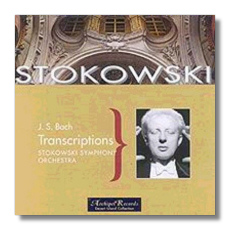
The Internet's Premier Classical Music Source
Related Links
- J.S. Bach Reviews
- Latest Reviews
- More Reviews
-
By Composer
-
Collections
DVD & Blu-ray
Books
Concert Reviews
Articles/Interviews
Software
Audio
Search Amazon
Recommended Links
Site News
 CD Review
CD Review
Johann Sebastian Bach

Stokowski Transcriptions - 1950
- Toccata & Fugue in D minor
- Chaconne in D minor from Partita #2
- Jesu, Joy of Man's Desiring - Chorale from Cantata #147
- We all believe in one God - Giant Fugue
- Sheep May Safely Graze: Aria from Cantata 208
- Fugue in G minor
- Boureé, from English Suite #2
- Komm, Susser Tod
- Prélude in B minor from Well-Tempered Clavier Book 1
- Chorale from Easter Oratoria
Stokowski Symphony Orchestra/Leopold Stokowski
Archipel 0056 rec. 1947; #1: 1950
There are basically four different sets of Stokowski's Bach transcriptions. The Philadelphia recordings are a must and all of them can be heard on Pearl [9098]
The next group of recordings is the one under consideration here, which were made in 1947 (the T&F) and 1950. Then came the London set and finally RCA. Each offers an interesting insight to the Stokowski Sound and this latest incarnation is really worth your time, even if you have the previous RCA disc.
Because the orchestra used on this release is so different from the others, I will not make any comparisons with those other recordings. As I have said elsewhere, the Stokowski Symphony Orchestra (aka "His Symphony Orchestra") consisted of some of the finest principal players in New York doing gigs with the Maestro. Bob Bloom (oboe) once told me that sometimes they didn't know what they were going to record until they got there. After the sessions Stokowski would manipulate the tapes to make the ad hoc group sound like a large orchestra. He created the Stokowski Sound with the new toys he could use. I bet he loved it.
So, what can be used as a reference point is the earlier RCA release [60922 nla]. I have no idea where Archipel came from. There isn't any information in the insert. The insert itself is more than odd. There is one photo, which has Stokowski standing over Sir Adrian Boult, who is seated at a piano, and Keith Falkner (whoever that is) standing next to them both. I have not yet figured out how this relates to the Bach transcriptions. The program here is the same as on the RCA disc except that two items have had their order changed around.
For a specific comparison I chose to listen to "Komm, Susser Tod". I chose this because I had a direct influence on it being on the disc. I first found out about the contents of the RCA disc in a conversation with Jack Pfeiffer in 1994. Jack was the head of the classical releases at that time. He told me what was going to be on the disc, but "Komm, Susser Tod" was not on the list. I mentioned that it would easily fit and he said it was a great idea and would have it added.
In the Archipel release I notice the solo violin soaring sweetly above the lower strings, like an angel hovering over us. This detail is not as present on the RCA issue. I also notice that the instruments have a position and a back-to-front perspective. Checking both discs it seems they come from the same tape source. There is no LP swish on either. Archipel, however, has apparently added some reverb and transferred it using 24-bit technology. The sound is more natural, less congested than the RCA issue. Solos are beautiful, making clear not only the virtuosity of the players, but also their poetic abilities.
So, for a sawbuck, you can add this to your collection. If you already have the RCA issue you should keep it for the excellent notes (written by yours truly) but you should add this as well.
Copyright © 2002, Robert Stumpf II


















